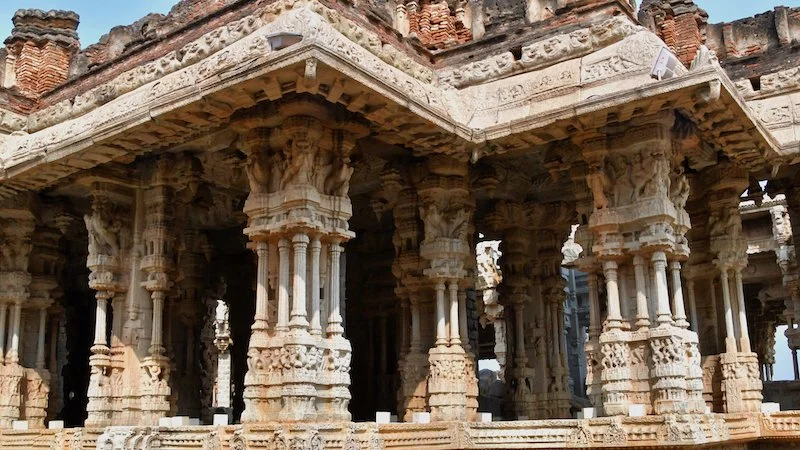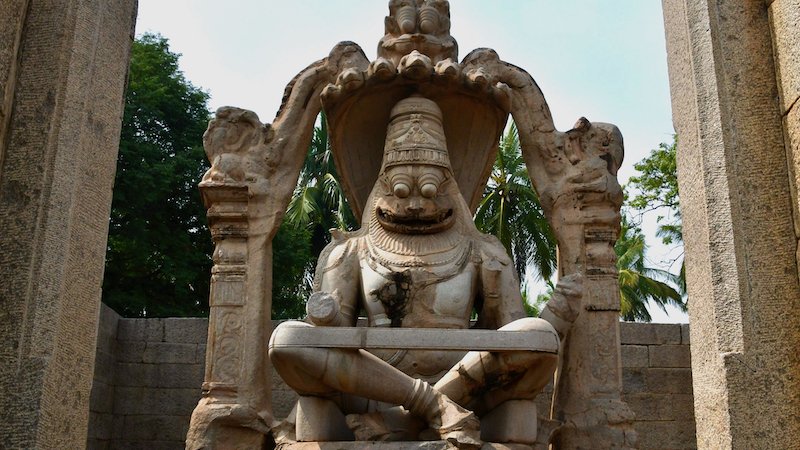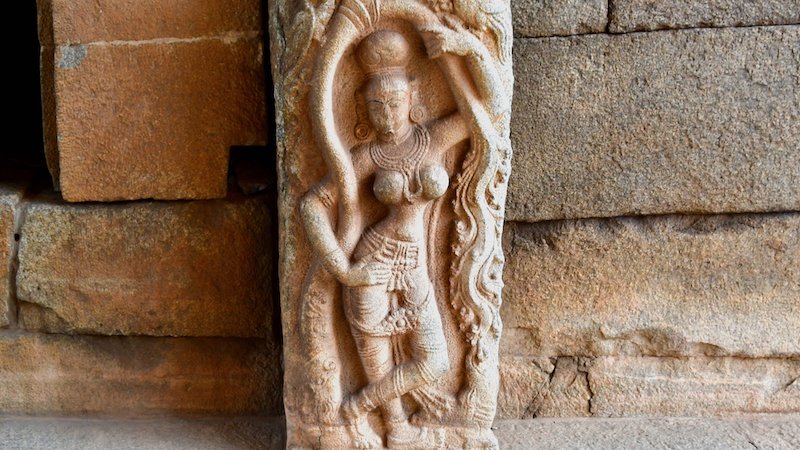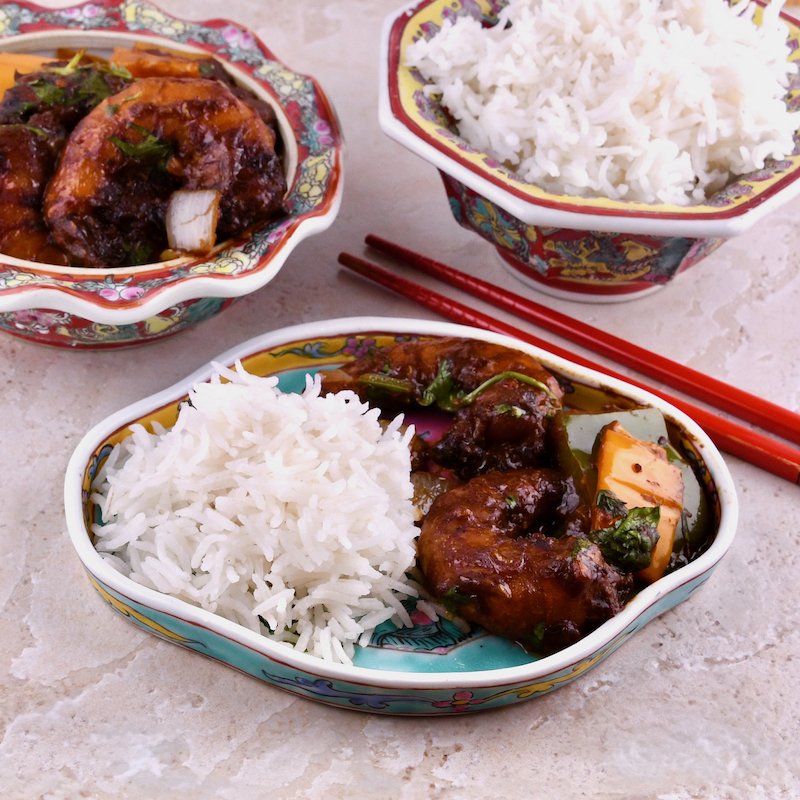Black Pepper Shrimp In Hampi, India
On our wish list of places that we hoped to visit someday, the small town of Hampi in the Indian state of Karnataka has ranked very high for years. Hampi is surrounded by the sprawling ruins of the great city of Vijayanagara, once the the capital of a great medieval empire that ruled southern India from the fourteenth to sixteenth centuries. At its peak Vijayanagara was one of the largest cities in the world, one that a fifteenth-century Persian traveller said was “such that eye has not seen nor ear heard of any place resembling it upon earth”. At last, during a recent trip to Bengaluru, we got our chance to see the magnificent monuments that have left visitors awestruck for centuries.
A six hour car ride took us from Bengaluru to Hampi, where there are several hotels and resorts catering to the increasing numbers of tourists who are rediscovering Vijayanagara. We stayed there for two days while exploring the carefully restored remains of the city, now a UNESCO World Heritage Site. The buildings sprawl over an area of four square miles, with towering temples, Ganesha statues, ornate palaces, baths, marketplaces and even an enormous stable for elephants!
Vijayanagara confronted a rapidly changing world during an era when India was buffeted by external forces. To its north it faced several Muslim kingdoms, established by Turk and Afghan warlords who had invaded India in the thirteenth century. Vijayanagara alternated between warring and trading with these neighbours while also being deeply changed by them. The architecture of the city reflects this influence - temples constructed according to classical Indian principles stand next to the Lotus Palace, built as a summer pavilion in a distinctly Islamic style.
Portuguese ships landed on the western coast of India in 1498, searching for the fabled spices grown in southern India, which commanded exorbitant prices in Europe. Over the next century many Europeans came to Vijayanagara to buy pepper, cardamom, cloth and gems. The city has vast markets with rows of stalls identifiable by their distinctive flat roofs supported by stone pillars. Once, these markets rang to the cries of vendors hawking their goods and the clamour of haggling clients. Other Europeans came to live and work in Vijayanagar, many enlisting as soldiers skilled in the use of muskets and cannons that were transforming warfare in India. Several wrote accounts of their stays, giving us detailed descriptions of life in medieval India.
The past is never clearly separated from the present in India. The Virupaksha temple in the center of the city rises above the surrounding ruins, filled with devotees as it has been since the 7th century. The temple predates Vijayanagara and was a well known pilgrimage site when the city was founded. It has now outlasted the city by five centuries and still attracts throngs of worshippers.
An elephant stands in the temple courtyard as monkeys scramble over its walls. The sound of bells can be heard in the distance. It is a scene that could have been staged a thousand years ago - it is hard to tell what century we are in.
The stone chariot outside the Vittala Temple is one of the most iconic sights in Vijayanagara, looking for all the world as if it is ready to roll away. Being made of solid rock, including its wheels, it is not likely to be moving anytime soon, which is just as well since local folklore has it that the world will end when the chariot begins to move!
The Vittala Temple has other marvels, above all its dance hall with stone pillars that resonate with a clear musical tone when struck. The pillars are built in groups of eight, each with a different diameter, so that they play different notes of the classical Indian musical scale. An entire orchestra can play, using only the pillars of the hall as instruments!
Vijayanagara imported enormous numbers of war horses that were essential for cavalry warfare but were bred only in the steppes of central Asia. Many Persian, Uzbeg and Tajik horse merchants sailed for south Indian ports in ships filled with horses. They must have been a very familiar sight in city markets since the walls of temples are covered with carvings of central Asian horse dealers and soldiers wearing their distinctive hats.
Vijayanagara’s splendour coincided with the height of the Ming Empire in China. Great fleets from China came to Indian ports, buying huge quantities of pepper and cardamom. Chinese merchants were also frequent visitors to the city, joining the dizzying variety of other nationalities who came to make their fortunes. Trade between China and India has continued without interruption ever since that time. In later centuries large numbers of Chinese settled in India and created a distinctive Hakka cuisine, tailoring Chinese dishes for Indian tastes, that is now immensely popular.
Black Pepper Shrimp is a delicious Hakka restaurant favourite that is easy to prepare at home. You can also substitute chicken or paneer for the shrimp and serve it with stir fried noodles instead of rice. Cut back on the black pepper and chili sauce for less heat, or throw in sliced green chilies for more! Check out more Hakka recipes here: Chicken and lamb dumplings, Grilled Lamb Skewers and Grilled Tofu Skewers, or sprinkle some Hakka spice blend as a finishing touch!
Black Pepper Shrimp
1 lb large shrimp, peeled and deveined
1 tbsp + 1 tsp cornstarch, divided
2 tbsp soy sauce, divided
2 tsp coarsely ground black pepper, divided
1 tbsp each: rice vinegar, tomato ketchup
1 tsp each: sesame oil, hot chili sauce
3 tbsp oil
2 cloves garlic, chopped
1/2 inch piece ginger, finely chopped
1 onion, chopped
1/2 each: sweet red bell pepper, sweet green bell pepper, cubed
2 tbsp chopped fresh coriander
2 green onions (scallions), chopped
Place shrimp in a large bowl, add 1 tbsp cornstarch, 1 tbsp soy sauce and 1 tsp ground black pepper. Stir to mix until shrimp are coated with the thick paste, adding a few drops of water if necessary. Set aside for 10 - 15 min while you prep remaining ingredients.
Combine 1/2 cup water with remaining 1 tsp cornstarch, 1 tsp ground black pepper, 1 tbsp soy sauce, rice vinegar, tomato ketchup, sesame oil and hot chili sauce in small bowl, stirring till smooth. Reserve for later use in the recipe.
Warm oil in deep non stick wok over medium high heat. Add the shrimp, stirring to cook them quickly until they are lightly crisped up, about 3 min. Transfer to a separate bowl.
Add the garlic and ginger to the remaining oil in the wok. Saute for 30 sec, then add the onions and sweet peppers. Saute for about 3 min until they are crisp tender.
Add shrimp to the wok and toss well to mix. Reduce heat to low and mix in the reserved soy sauce cornstarch mixture, giving it a quick stir to recombine. Stir for about 30 sec until the sauce is thickened and coating the shrimp.
Fold in the chopped fresh coriander and green onions.
Transfer shrimp to a serving dish and serve with rice.
Serves four



















